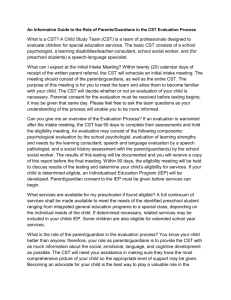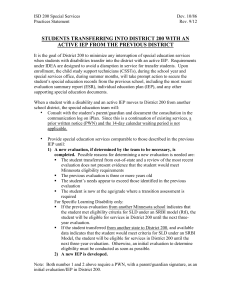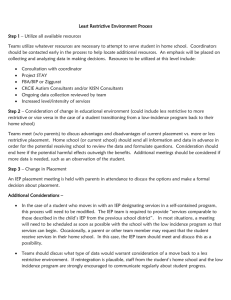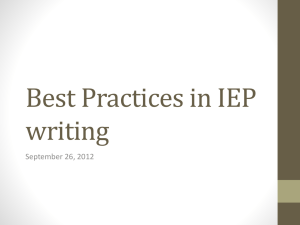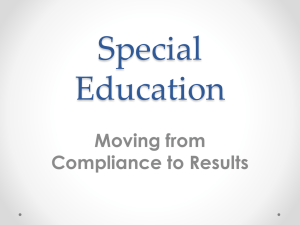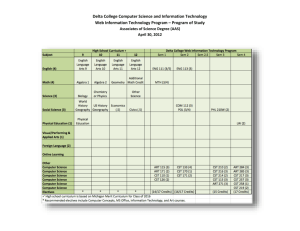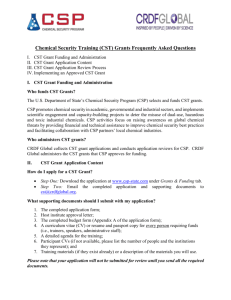CSTFrameworkOverview
advertisement
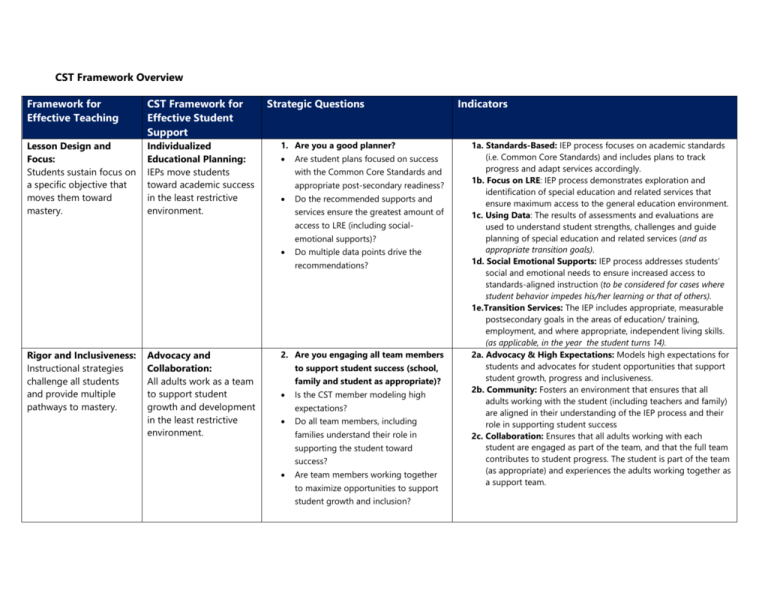
CST Framework Overview Framework for Effective Teaching CST Framework for Effective Student Support Lesson Design and Focus: Students sustain focus on a specific objective that moves them toward mastery. Individualized Educational Planning: IEPs move students toward academic success in the least restrictive environment. Strategic Questions 1. Are you a good planner? Are student plans focused on success with the Common Core Standards and appropriate post-secondary readiness? Do the recommended supports and services ensure the greatest amount of access to LRE (including socialemotional supports)? Do multiple data points drive the recommendations? Rigor and Inclusiveness: Instructional strategies challenge all students and provide multiple pathways to mastery. Advocacy and Collaboration: All adults work as a team to support student growth and development in the least restrictive environment. 2. Are you engaging all team members to support student success (school, family and student as appropriate)? Is the CST member modeling high expectations? Do all team members, including families understand their role in supporting the student toward success? Are team members working together to maximize opportunities to support student growth and inclusion? Indicators 1a. Standards-Based: IEP process focuses on academic standards (i.e. Common Core Standards) and includes plans to track progress and adapt services accordingly. 1b. Focus on LRE: IEP process demonstrates exploration and identification of special education and related services that ensure maximum access to the general education environment. 1c. Using Data: The results of assessments and evaluations are used to understand student strengths, challenges and guide planning of special education and related services (and as appropriate transition goals). 1d. Social Emotional Supports: IEP process addresses students’ social and emotional needs to ensure increased access to standards-aligned instruction (to be considered for cases where student behavior impedes his/her learning or that of others). 1e.Transition Services: The IEP includes appropriate, measurable postsecondary goals in the areas of education/ training, employment, and where appropriate, independent living skills. (as applicable, in the year the student turns 14). 2a. Advocacy & High Expectations: Models high expectations for students and advocates for student opportunities that support student growth, progress and inclusiveness. 2b. Community: Fosters an environment that ensures that all adults working with the student (including teachers and family) are aligned in their understanding of the IEP process and their role in supporting student success 2c. Collaboration: Ensures that all adults working with each student are engaged as part of the team, and that the full team contributes to student progress. The student is part of the team (as appropriate) and experiences the adults working together as a support team. Culture of Achievement: A learning-focused environment of shared high expectations promotes mastery. Case Monitoring and Reporting: Effective management ensures that eligibility and IEP processes are successfully facilitated. 3. Are you effectively managing the work? Are mandated timelines met? Are all team members informed at each step of the process (at minimum as code-mandated)? Are activities tracked in relevant data management systems? Student Progress Toward Mastery: Students show evidence of, and teacher monitors, growth. Student Progress: Students show evidence of growth. 4. Are students making progress? Are processes in place to monitor and track student progress? Are the special education services and supports effective? Is everyone working to appropriately refine services and supports? Commitment to Personal and Collective Excellence: The teacher demonstrates commitment to excellence and to the professional growth of his/her school and peers. Commitment to Personal and Collective Excellence: The CST member demonstrates commitment to excellence and to the professional growth of his/her school and peers. 5. Are you contributing to collective excellence? Is the CST member aware of his/her strengths and growth areas? Does the CST member seek and incorporate feedback into his/her practice? Does the CST member seek ongoing growth and development? Does the CST member contribute to colleagues’ and school improvement? Is the CST member consistently present and on time? 3a. Timeliness: Students are identified and services recommended in a timely manner; code-mandated timelines are met for initials, annual reviews and re-evaluations. 3b. Communication: Code-mandated communication is completed including evaluation requests and outreach to parents and teachers in a timely manner. 3c. Data Management: Systematic tracking and monitoring is in place; all information related to eligibility and IEP processes is appropriately entered into the data management tools. Data includes: referral, eligibility, and IEP processes; implementation and related service dates; and compensatory services data. 4a. Understanding of Student Needs: As needed and requested, assessments and evaluations are conducted effectively, including respectful interaction with students and families, data collected in a systematic way, outreach completed and meaningful reports/summaries created. 4b. Tailored Supports: Students receive high-quality services that support strengths and targets challenges. Systems are in place to track effectiveness and student progress. 4c. Responsiveness: Consistently monitors the effectiveness of special education and related services to ensure progress toward high standards. Systematically refines services as appropriate; initiating an IEP meeting when needed. 5a. Attendance and Planning: Attendance and time management reflect his or her focus on student progress as a priority. 5b. Contribution to the School Community: Contributes knowledge and expertise to school-based staff to further the efficacy of programming and further students’ growth in the least restrictive environment. 5c. Commitment to Continuous Improvement: Self-assesses strengths and growth areas, seeks and incorporates feedback from others, and pursues his or her own growth and development. 5d. Belief and Urgency: Demonstrates support to the mission of NPS to improve outcomes for all students with disabilities through increased access to LRE and inclusive practices.

